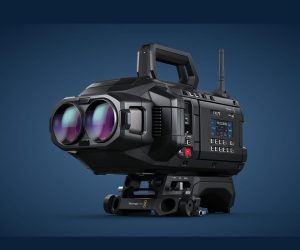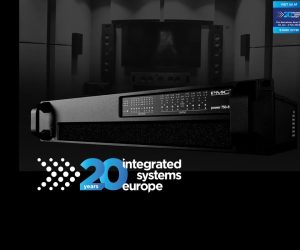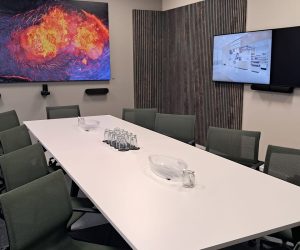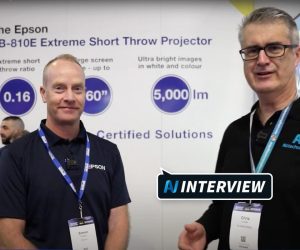
MASSIVE BLACKMAGIC NAB LINEUP
Blackmagic Design has introduced a huge lineup of products at NAB this year, chief among them a 4.6K image sensor with 15 stops of dynamic range for URSA cameras, three new cameras, a massive update to DaVinci Resolve, and a range of 12G-SDI products for broadcast, post production and live production.
“In total we are introducing 38 new products,” says Blackmagic CEO Grant Petty. “Each of these products has been a major engineering development and we feel we have really innovated in technology, industrial design and the user experience in every single one.
“A great example is DaVinci Resolve. Over the years we have worked hard to build in improvements in each release, however this year I feel we have added more new features to DaVinci Resolve than we have in the last 5 years combined. The new DaVinci Resolve 12 truly is now the world’s most powerful professional editor and it has over 80 new features including multi-cam, 3D keying, 3D tracking, pro audio with third party audio plug-ins, parameters in the timeline, more trimming modes than any other editor and much, much more. Even its user interface has been refined and is dramatically more elegant than ever before.”
URSA 4.6K Cameras
“When we introduced our URSA high end digital film camera last year, it was designed to be user upgradable,” Petty says. “The reason for this is we had secretly been working on a whole new generation of sensor technology that we wanted all URSA customers to have, without obsoleting the camera.”
The new 4.6K image sensor features a Super 35 size with a resolution of 4608 x 2592 at 120 frames per second. With an extremely wide 15 stops of dynamic range it rivals most traditional 35mm film stock.
There are two new models of URSA with the new sensor: the 4.6K EF and the 4.6K PL, which will be available for AU$9845 and $10,555 respectively. Both will ship in limited quantities in June, and ramp up to full volume in late July and into August.
Those who already own an URSA can upgrade to the 4.6K sensor with a ‘4.6K turret upgrade’, which costs US$1995 for the EF lens mount and US$2395 for the PL lens mount. The company has also reduced the price of the original URSA EF and PL cameras by US$1000, and released an update for the URSA 4K models that adds new features and frame rates, which is downloadable from the company’s website.
URSA Viewfinder
The new VF has a resolution of 1920 x 1080 in a colour OLED display and has been custom designed from precision glass optics, with an adjustable diopter and built in digital focus chart. It simply bolts onto the front of the URSA camera and then the SDI and power plug into the sockets on the side. It’s adjustable for left and right eye use and there are built in overlays, focus zooming, focus peaking and a tally record light on the viewfinder as well.
The URSA Viewfinder will be available in July for AU$2119.
URSA Mini
The original URSA is a beast and quite a lot to hold for a smaller crew, which is part of the reason BM has designed a much more portable version in the Mini. It doesn’t have all the features of its bigger brother but it does contain the same 4K and 4.6K sensors and the core processing of the original.
It’s made from magnesium alloy and its compact design is light enough to use as a hand-held camera, much like the way a DSLR is used. It’s also compatible with the new URSA Viewfinder and features frame rates up to 60fps, with a 5-inch full HD touch screen (that folds out and angles), it records to dual CFast cards and has a side handle that has a LANC based record, focus and iris buttons. The Mini has multiple mounting points for accessories such as lenses, rails, matte boxes and more. There’s also an optional URSA Mini Shoulder Kit with a shoulder pad and built-in quick release mount.
There are four versions of URSA Mini: 4K EF (AU$4235), 4K PL (AU$4925), 4.6K EF (AU$7035) and 4.6K PL (AU$7755). The range will be available late July.
Micro Cinema Camera
The new Micro Cinema Camera is a miniaturised Super 16mm professional digital film camera with a new expansion port that lets you use PWM and S.Bus model airplane remote controls to operate the camera wirelessly for capturing action anywhere.
“What this means is you can use the same low cost radio control gear that hobbyists use for model aircraft and quadcopters,” explains Petty. “Normally these receivers plug into ‘servos’ which generate movement when the user adjusts a knob on the hand held transmitter. These connections use a voltage called PVM and we have the same connection on the Micro Cinema Camera. So this means you can plug into the camera and control the camera remotely.
“You can even map what camera feature you want on what channel. So you could map the lens to adjust iris or focus. You could use a channel to start and stop recording, so you don’t fill the SD card with RAW or ProRes files before you are ready for your shot.”
It features an MFT mount, 13 stops of dynamic range, front facing controls, a tally light, HDMI and composite NTSC/PAL outs. The Micro Cinema Camera will be available in July for AU$1405.
Micro Studio Camera 4K
The Micro Studio Camera 4K may look the same as the new Micro Cinema Camera but it’s a broadcast quality UHD studio camera. It can be used with an external recorder as a production camera but really comes into its own when used in live production with a live production switcher.
Its features are almost identical to its bigger brother, the full sized Studio Camera 4K, with SDI in and out (6G-SDI) featuring the same SDI control protocol as the ATEM switches (and other BM studio cameras). It also has a built-in colour corrector and supports UHD frame rates up to 30fps, and 1080 HD frame rates up to 60fps. It features a PTZ serial connection out (which can be used for controlling a remote head) and B4 lens control connection (for broadcast lenses). Any pan, tilt and zoom commands sent to the camera via SDI from the switcher will be output on this PTZ connection, and if you have a zoomable MFT lens it will adjust the zoom on the lens as well.
“We have been asked for this a lot by high end broadcasters and now with this camera and the B4 lens connection you can add accessories to turn this camera into a fully featured studio camera,” Petty says. “Imagine using it as a full sized studio camera with external monitor and broadcast lens. Or using it on set concealed so you can get all kinds of exciting and interesting camera angles.”
The Micro Studio Camera 4K will be available in July for AU$1845.
DaVinci Resolve 12
DaVinci Resolve 12 has more than 80 new features including a new modern interface, multi-cam editing, new media management tools, an entirely new professional audio engine with support for VST/AU plug-ins, automatic shot matching, 3D keyer, new 3D perspective tracker, and enhanced curve editing.
The new UI has a lighter colour scheme with a new top down navigation and a new multi-camera editing feature, which allows editors to cut programs from multiple sources in real time.
Improvements have been added to the editing tool including all trim modes; multi-slip, slide, ripple and roll have been extended and editors can now select multiple points for dynamic trimming and asymmetric trimming of clips (even when on the same track). Timelines can now be nested, edited together and expanded or collapsed in place, and new transition curves allow editors to customise curves for transition parameters, with on-screen controls to adjust motion paths directly in the timeline viewer.
The new audio engine features editable automation, a full curve editor, scrubbing and reverse scrubbing, dynamic JKL trimming and support for VST/AU plug-ins. Users can also export projects directly to ProTools via AAF for mastering.
Media Management has also had an overhaul and users can now manage projects and media using new copy, move, transcode, relink and consolidate tools, and import by just dragging footage directly into bins. Archiving has been added along smart bins that display footage based on metadata tags.
ACES 1.0 transforms have been added and a new curves interface, automatic color analysis and matching, a 3D perspective tracker, and a new 3D keyer with improved matte finesse options. Colourists can now define their own smart filters, convert any window to a bezier, collapse multiple nodes into compound nodes to simplify their view, ripple grades across multiple clips, and flatten pre and post-group grades into a clip’s individual grade.
Remote rendering is supported to allow distribution of rendering jobs to other Resolve systems that are on the same shared database and shared storage.
DaVinci Resolve 12 is a free upgrade for existing DaVinci Resolve customers.
Fusion 8 Studio
Finally, Fusion 8 is coming to Mac OSX and Linux systems. The update will be released around the third quarter of the year with a public beta possibly available beforehand. Fusion has been used as a tool in VFX and motion graphics for more than 25 years, and has been used on thousands of feature film and television projects, including blockbusters Maleficent, Edge of Tomorrow, Sin City: A Dame to Kill For, The Amazing Spider-Man 2 and The Hunger Games, as well as hit television shows including Battlestar Galactica and Orphan Black.
The Windows based Fusion 8 is free of charge and for download from the BM website.
Video Assist
Video Assist is a portable, all-in-one professional monitor and video recorder that can be used with any camera or DSLRT with SDI or HDMI camera, adding professional ProRes recording and full resolution HD monitoring. It can be mounted on cameras as a large monitor, be handed to the cinematographer or DOP for setting up shots, or set on a table in front of the director to review each take.
The 5-inch 1920 x 1080 HD monitor and touchscreen offers a wide 135º viewing angle and records broadcast quality 10-bit 4:2:2 video onto SD cards in ProRes file formats. The touch screen uses swipe gestures for changing settings and displaying video and audio levels on its ‘heads up’ on screen displays. It also has a 6G-SDI input so it can be also used as a UHD monitor.
Video Assist will be available in July for AU$699.
Teranex Mini
The new Teranex Minis are a range of 12G-SDI mini converters which are slightly different to normal converters.
Petty explains: “Regular Mini converters cannot dissipate the heat generated from 12G-SDI, they have cumbersome power supplies, they cannot use standard XLR connectors and they only have switches for control. Teranex Minis solve all these problems and easily handle the speeds of 12G-SDI without overheating for all video formats from SD to HD, and Ultra HD. 12G-SDI allows Teranex Minis to operate in all video standards up to 2160p60 on a single BNC cable.”
There’s also an optional ‘smart’ front panel with spin knob, color LCD and multiple buttons, which allows users to see the video being converted, monitor audio levels, verify timecode and the video standard being converted. They can also be rack mounted when using the optional rack tray.
Teranex Minis feature a built in power supply and Ethernet connection that can also power the converter, and feature XLR connectors, AES/EBU and timecode connections and completely redesigned audio electronics with a low noise floor of more than -115dBFS.
There are six models of Teranex Mini: SDI to HDMI, HDMI to SDI, SDI to Analogue, Analogue to SDI, SDI to Audio, and Audio to SDI, along with six optical fiber models that include a single SDI connection and a 12G-SDI SMPTE compatible optical SDI module: Optical to HDMI, HDMI to Optical, Optical to Analogue, Analogue to Optical, Optical to Audio, and Audio to Optical. The models start at AU$699 and will be available in May.
ATEM 2 M/E Broadcast Studio 4K
The new ATEM 2 M/E Broadcast Studio 4K is a fully 12G-SDI based switcher with 20 inputs, and built-in features including DVE, SuperSource, six keyers and transitions, all in Ultra HD up to 2160p60. All inputs still include full re-sync.
The new model has double the size media pool and the two built-in multiviewers are HD or UHD, along with four builtin media players. The model will start shipping in June for AU$8445.
HyperDeck Studio 12G
The new HyperDeck Studio 12G supports all video formats from SD, HD and UHD up to 2160p @60fps. It features the same VTR style controls as the other HyperDeck models and includes advanced 12G-SDI and HDMI 2.0 connections for recording and playback of high frame rate Ultra HD over a single BNC cable. It will be available in May for AU$3515.
Smart Videohub 12G 40×40
The new Smart Videohub 12G 40×40 is a native 12G-SDI router with 40 inputs and 40 outputs. It’s multi-rate so it automatically works with all SD, HD or UHD equipment, and can route multiple different video formants on the same router at the same time. It will be available in May for AU$7035.
Smart Videohub CleanSwitch 12×12
The new router is part of the regular 6G-SDI router range so it can work with all video standards including SD, HD and Ultra HD up to 2160p30. What’s different is that every single input has a full re-sync.
“What this means is that if you have multiple untimed video sources of the same video standard, this router will re-sync those sources and then you change the route to a router video output, the switch over will be perfectly clean without any glitches or slow monitor re-locking,” Petty explains. “That’s important when routing to a big display or projector at a public venue where you want the route changes to be clean cuts.”
Smart Videohub CleanSwitch 12×12 will be available in May for AU$2119.
ATEM Talkback Converter 4K
The new ATEM Talkback Converter now has BNC 12G-SDI connections so you can run simple BNC SDI cables to the cameras. It supports up to eight cameras so you can double the number of cameras you can talk with on the one unit. The converter will be available in May for AU$3515.
UltraStudio 4K Extreme
BM says this is world’s most advanced Thunderbolt and PCIe video capture and playback solution. It features a quad link 12G-SDI, HDMI 2.0 and a built-in multi-format hardware codec encoder that includes encoding to H.265 compressed streams.
UltraStudio 4K Extreme can work with super high resolution and frame rates up to 3D stereoscopic 4K at 2160p60. It comes in a rackmount design, and includes a full copy of DaVinci Resolve 12. It will be available in June for AU$4235, and the H.265 encoding will be a free update that should be available in July.
DeckLink 4K Pro
DeckLink 4K Pro is a new lower cost 12G-SDI solution for capture and playback. This new model features dual link 12G-SDI in and out, so it supports real time capture and playback of fill and key channels even when operating up to 2160p60, includes video reference input, and supports Mac, Windows and Linux as well as BM’s DeckLink SDK. AU$845.
Source: Blackmagic Design media releases
LINKS
Blackmagic Design: www.blackmagicdesign.com
New Magic Australia: (03) 9722 9700 or www.newmagic.com.au






























RESPONSES